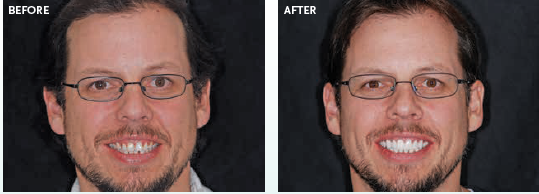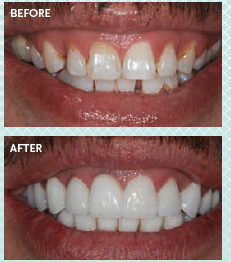
A Full Mouth Reconstruction for a Lifelong Friend.
Performing life-changing dentistry is always a joy, but it is especially gratifying when it involves helping out a lifelong friend. That’s exactly what happened in the spring of 2014, with a case that I worked on as part of the Clinical Hands-On course with the Dr. Dick Barnes Group (DDBG) in Denver, CO.
An Unfortunate Accident
Greg (the patient) and I have been friends since high school, and we were roommates during our freshman year at the University of Wyoming in Laramie, WY. In high school, Greg had a minor skiing accident—he hit his teeth with a ski pole. Eventually, the upper front tooth (tooth number 8) that was hit became discolored.

Because of the discolored tooth, Greg became self-conscious about his smile. Not only did he have the discoloration issue, but he also had issues with large gaps between some of his teeth. As a result, he would seldom smile with his teeth showing for photographs, and when he laughed he would cover his mouth with his lips or fist.
Creative Solutions
Greg was so unhappy with the way his teeth looked, he attempted a creative solution. He went to the local Walmart and bought some paint to apply to his teeth. Not surprisingly, it didn’t work out and Greg reverted to the old methods of hiding his teeth manually so that no one could see them.
Hiding his smile was particularly difficult for Greg because of his outgoing personality. He’s naturally the type of guy who has never met a stranger. He is comfortable talking to most people and will do just about anything for anyone.
In the years since the accident, Greg became more and more self-conscious about his smile. It started to cause him social anxiety and it affected how he interacted with others. His smile and his personality were at odds with one another.
Greg and I have stayed in touch over the years, and would often connect when we were both in our hometown for the holidays. On one of those visits in 2013, Greg approached me about an idea that he’d been considering.
He was at a point in his life when he was serious about doing something about the appearance of his teeth. He felt the only solution was a drastic old-school one—pull them all out and wear dentures. I was shocked that a man in his thirties would consider such an idea, and I encouraged him not to do something so extreme without giving it a great deal of thought.
A Better Way
Fortunately, a short time after our conversation, I attended the DDBG Full Arch Reconstruction course led by Dr. Jim Downs of LêDowns Dentistry in Denver, CO. During the course, I became more familiar with full arch reconstruction and the types of procedures and services that are offered by Arrowhead Dental Laboratory.
As soon as I learned about a predictable way to approach large-case, comprehensive dentistry, I thought of Greg. I was excited to talk to him and tell him about what I had learned during the course, and about what options were available.
Approaching Greg with the case presentation wasn’t difficult. He was already willing to go to drastic measures to change his teeth, so I knew that he’d be open-minded about another option. At the time, finances weren’t a large concern for Greg, either, so I knew that wasn’t going to be a roadblock for him.
My mission was to talk with Greg about a full mouth reconstruction. I felt strongly that it would be a far better solution than dentures. For Greg, full mouth reconstruction would unleash the power of cosmetic dentistry as a vehicle for changing his life.
I explained to Greg that with no periodontal disease and no generalized bone loss, there was no reason to remove all of his teeth. His quality of life would greatly improve after a full mouth reconstruction—much more than it would with dentures.
Remodeling the Facade
I used an analogy that I found to be helpful not only for Greg, but for my other full mouth candidates as well. I asked Greg to compare his teeth to a house that needs to be repaired. The foundation is solid—he just needs to do some remodeling.

![]()
In the process, the framework stays the same and only the facade changes. For example, if there are certain things you don’t like about a house, you can make cosmetic changes to it. If you don’t like the siding, you can paint it or install new siding. If you don’t like the kitchen, you can replace the countertops, paint the walls, put in new cabinets, and install new appliances.
But you would never tear down an entire house just because you don’t like certain cosmetic things about it. The same is true with teeth. The foundation is the most important part. As long as the foundation is solid (and Greg had a solid foundation), if you don’t like certain aspects about how your teeth look, or how they function, those things can be altered and improved.
Getting a Visual Image
As part of our conversation, I also told Greg that the doctor who would be leading the course—Dr. Downs—had a dental practice close to where Greg lived in Colorado.
I told Greg that if he decided to move forward with his plan to get dentures, he’d have to find another dentist. In good faith, I couldn’t do such a procedure to a young and otherwise healthy patient, especially after learning about the superior methods available through aesthetic dentistry.
Greg pondered the options for some time. We discussed the methods that would be used, and the timelines of his case. He researched some of the things we had discussed and saw before-and-after photos of other cosmetic cases. The photos helped him understand what the procedure would be like and the kind of results he should expect. Once he had a visual and saw the possibilities of the procedure, he was pumped. “Let’s do it!” he said, and immediately jumped in with both feet.
At the Wax-Up appointment, Greg was pleased with the overall look. After a close examination of the model, he asked to slightly change the shape of a premolar—tooth number 4. He also wanted to go a shade lighter on the tooth color than what we had originally suggested. Greg is a very detail-oriented person and he enjoyed having an active part in designing his teeth.
Expect the Unexpected
One of the lessons I learned from this case is to expect the unexpected in dentistry. During the full examination of Greg’s mouth, I discovered that tooth number 8 had a horizontal root fracture. In retrospect, this shouldn’t have been much of a surprise considering it was one of the teeth that had been damaged in the skiing accident.

![]()
However, finding a crack in the foundation did alter the initial plans a bit. We ended up extracting the tooth, completing a bone graft, and placing a collagen graft to accommodate the bridge from tooth number 6 to tooth number 9. This bridge was in addition to another bridge we placed from tooth number 3 to tooth number 5.
We opted not to do an implant for tooth number 8. Greg was anxious to complete the entire process and didn’t want to wait months for his new smile.
Another change in the treatment plan occurred on the lowers. Initially, we weren’t planning on crowning tooth number 21. However, after further examination, we discovered that in order to take care of the diastema between tooth number 21 and tooth number 22, we would have to make tooth number 22 much larger.
Such a large restoration would not be aesthetically pleasing, and might look and feel awkward, so we decided to split the difference in the size adjustments and crown both tooth numbers 21 and 22.
We also found that the gum on tooth number 24 had recession and the frenum had a high attachment, causing the recession. Instead of doing a soft tissue graft, we released the frenum with the CO2 laser.
This was the best solution for the gums. Greg hasn’t lost any more gingival height since that time, and in fact has had about a 1mm gain of tissue coverage in that area.
We prepped Greg’s full mouth reconstruction in one appointment. It took a solid nine hours—we started at just after 8 a.m. and finished sometime around 6 p.m., with a short break for lunch. This was the first full mouth procedure I had prepped in a single appointment.
It was an exhausting day for both the patient and the dental team, but in the end, it was well worth it since the patient could get everything done at once and be that much closer to a permanent restoration solution.
At the conclusion of the course the following month, Dr. Downs and I met with Greg again. At that appointment, we seated and bonded the permanent restorations, and used the Tekscan® to balance the occlusion.

Final Results
We were extremely pleased with Greg’s final results. Not only have Greg’s teeth improved, but so have the overall contours of his face. His facial lines are softer now, the dimples in his cheeks aren’t as pronounced, and the area underneath his eyes are fuller. These facial feature improvements are an added benefit to Greg’s full mouth reconstruction.
The overall change in Greg’s demeanor is also a natural result of the full mouth reconstruction. As mentioned previously, Greg has always been an outgoing and happy person. But today, he no longer hides his smile or acts self-conscious about his teeth. He catches himself smiling all the time. He says it took him a while to “learn to smile” properly again, but Greg’s smile now matches his confidence.
Greg’s procedure actually turned out better than we had originally planned. We were pleased with the fact that we immediately handled any challenges that arose during the procedure. From Greg’s perspective, the only thing he would change would be to have done the procedure earlier in his life—a sentiment echoed by many full arch reconstruction patients.
Fortunately, Greg now lives in Arkansas, about one and a half hours from my practice in Oklahoma, so he’s able to come in for regular appointments for checkups and any future dental work that might need to be done.
Life-Changing Dentistry
Prior to the procedure I told Greg, “When we put these crowns on, it will change your life.” And trying to be a tough guy, he just kind of shrugged that off. However, when he first saw his teeth after we bonded the permanents, he got emotional and started to tear up—actually, truth be told, we both did!
He admitted that on the drive home from Denver, he couldn’t stop looking in the rear-view mirror at his teeth. In fact, he reported later that day that his face was hurting, not because of anything from the procedure, but because he just couldn’t stop smiling.
Shortly afterwards, Greg was at his first professional engagement of the year—at a corporate board meeting in California. A female colleague saw him and exclaimed, “I know what you did with your bonus money! You got your smile made over!” That made him feel not only happy, but also justified that other people noticed him and the improvements he had made to his physical appearance.
He now knows how much his new smile has affected his overall confidence and the way he interacts with others, and how others interact with him. We’re all extremely happy that with Greg’s solid foundation, he decided to forgo dentures and instead chose a full mouth reconstruction.
As long as the foundation is solid, if you don’t like how your teeth look or how they function, they can be altered and improved. A great “remodel” job really can make all the difference in the health, happiness, and overall confidence of any of your patients.









